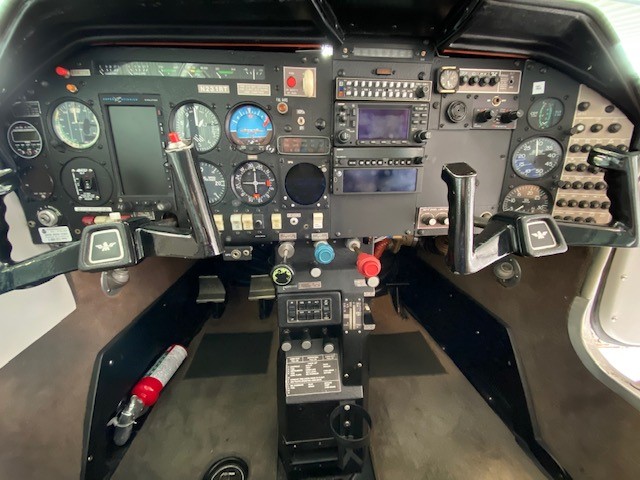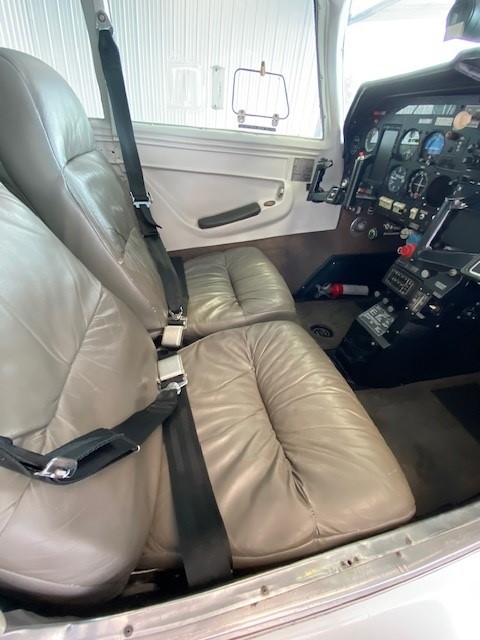
snowds
Basic Member-
Posts
19 -
Joined
-
Last visited
Recent Profile Visitors
The recent visitors block is disabled and is not being shown to other users.
snowds's Achievements
-
*SOLD* M20K Rocket Conversion Modern Panel Personal Airliner
snowds replied to snowds's topic in Aircraft Classifieds
We recently took out the back seat to replace the plastic side walls. It took around 20 min. Would have left it that way had I not had the image of my kids standing there with there teddy bears ready to go on a trip but having nowhere to sit. -
*SOLD* M20K Rocket Conversion Modern Panel Personal Airliner
snowds replied to snowds's topic in Aircraft Classifieds
Hmm, I'm not sure, a lot of people reach out from the trade a plane ad. I'm definitely not hiding! -
Hello MS'ers. I am reluctantly selling my 1981 M20K 305 Rocket. It was a fantastic plane for 18 years when our kids were small (and I was small-er), but alas, they've grown and so have our space and weight requirements. Here are the specs: TT: 4,900 SMOH: 300 (Zephyr) Annual and IFR expire May 2022 (both being completed this coming week) At 10K feet, you'll enjoy around 200kts TAS, at FL180, you'll get around 218kts TAS. Fully coupled GPS steering auto-pilot will fly the approach for you (including LPV), and fly the missed approach and hold. Lynx NGT9000 ADS-B IN/OUT provides weather and traffic to your PFD and your mobile devices. Long range fuel tanks hold a total of 105 gallons. Going too fast? No problem, throw out the speed brakes, and descend at 2,000+ ft/min. Fully feathering prop gives a glide ratio of 17:1: at 15K feet AGL, glide for ~45 miles. Twin batteries and twin alternators provide electrical backup. No vacuum instruments, everything is electrical, so no worries about vacuum failures. Aspen Avionics Evolution 1000 with weather/traffic Garmin GNS-430 WAAS GPS and Nav/Com Lynx NGT9000 Transponder with ADS-B In/Out Garmin SL-30 Nav/Com King 200 Autopilot Mid-Continent Backup Artificial Horizon w/ internal backup battery WX-1000E Strike Finder Fuel totalizer JPI EDM 700 Engine monitor Artex 406 MHz ELT coupled to WAAS GPS Backup alternator with automatic switching Twin batteries Electrical hot-prop deicing LED landing light LED rear strobe and position light New interior plastic on pilot panel and right rear passenger panel Gross weight increase STC to 3,200 Monroy long-range fuel tanks, resealed in 2013 by Wet Wingologists Precise-Flight Speedbrakes Paint 6/10, some areas wearing through to metal Interior 8/10 NMDH, just usual hanger dings, complete logs back to day 1 Asking $154,000 Contact me through Trade-A-Plane, or at snowds@yahoo.com (no sell side brokers please) Thanks!!
-
M20K Rocket Breather Tube-Picture Wanted
snowds replied to snowds's topic in Modern Mooney Discussion
+1. The quick drain on mine is a piece of cake with the Rocket-supplied drain tube, and removing the oil filter is trivial in mine, certainly not requiring removal of an intercooler. Hardest part of doing an oil change is putting the bottom cowling back on. I can definitely see the oil change process hindered by the separator, but maybe worth it for a clean belly. -
M20K Rocket Breather Tube-Picture Wanted
snowds replied to snowds's topic in Modern Mooney Discussion
Great, let us know how it goes. At one point, we connected an airspeed indicator to the filler, and ran it at full power. We saw no increase in pressure in the crankcase. However, we did not try doing it in flight, which is a much better experiment. -
M20K Rocket Breather Tube-Picture Wanted
snowds replied to snowds's topic in Modern Mooney Discussion
Hi all. FloridaFlyer reminded me via PM to get my butt on here, so thanks to FloridaFlyer for the reminder. The oil loss through the breather hose continued sporadically until we did an overhaul last year. Even with the new engine, the cowling gets a few drops of oil on each flight, but nothing like what it used to be. The oil shows up on the outside of the right gear door; the only way that can happen is when the gear is up and the doors closed. No oil shows up on the left door, which tells me this is happening in cruise, not during takeoff, climb, or landing, when the left door is right next to the breather. One thing the overhauler mentioned is the possibility that the cap locking lobes on the filler neck tend to wear down over time, leaving the dipstick less tight than it should be, thus allowing air flow into the crankcase, especially when the engine compartment is at high pressure during high speed ops. When we talked to Continental about the issue, they said first replace the entire dipstick and o-ring (they said do not replace just the ring, and definitely do not double the ring). Then, if the problem persists, change the prop seal. My working hypothesis is that even a new prop shaft seal isn't enough to completely block air from entering the crank at the speed the Rocket goes, and a less than perfect shaft seal just causes that much more oil to blow. Unfortunately, I have no practical way to test this hypothesis. With a new engine, it's just a couple/few drops per flight now, which I can live with. Hope that helps! Stephen -
Rocket Owners -- Operating Methods
snowds replied to Openwheeler3's topic in Modern Mooney Discussion
Add me to the list that tried GAMI LOP. I ended up having to take it to GAMI to try to get the injector flows right; ultimately, they pulled the GAMI injectors, and used stock injectors for which they had measured the flows. I ran it LOP for a while, and burned a hole in one of the exhaust elbows. Maybe it was related to running maximum TIT so much, maybe not, but that combined with the not-quite-smooth running shied me away from LOP in the Rocket. I cruise at 32 inches/2400 RPM, 75 degrees ROP. Usually comes out to 21-22 GPH. I generally do not add an inch of power per 10 degrees warmer than standard; the engine just gets too hot (I am usually in the high teens). I go into the pattern at 22 inches, max RPM, which gets me to 130 kts abeam the numbers, drop the gear, down to 17 inches, slowing to 90 kts by final, 85 kts over the numbers. For an ILS, 19 inches and 120 kts going into the FAF, gear down, 17 inches, half flaps, ride down the hill at 105 kts. -
Looking for PIREP on Wet-Wingologist East
snowds replied to FLYFST's topic in Modern Mooney Discussion
Eddie sealed my tanks 3 years ago. The right wing has started leaking under the non-skid at the entry of the cabin (where one walks). Eddie has agreed to fix it under warranty as soon as I can get it down there. He has been very responsive. One piece of advice: A few months after the reseal, the aux tanks started leaking around the drains, and I had to fly down there to have him put in new drains (not under warranty). If you are going to go all the way down there, just have everything done and take no shortcuts. -
Firewall Forward Rocket Overhaul Cost Breakdown
snowds replied to KevinR's topic in Modern Mooney Discussion
Finally got the overhauled Rocket running perfectly smooth at low power settings (16 inches and below, on final). It is critical that the fuel flow set up be done exactly according to the Rocket STC document (and not the Continental service bulletin); the fuel system builder swore there was no way the engine would run properly being set so lean at the low-end. Against his intuition, the A&P took two full turns on the low end fuel flow screw, and it fixed the roughness. Ridiculously smooth now. He had never set an engine so lean that there is no RPM increase when leaning on the ground at 1,000 rpm, but that's what the STC called for, and that's what ended up working. When all else fails, read the directions! -
Firewall Forward Rocket Overhaul Cost Breakdown
snowds replied to KevinR's topic in Modern Mooney Discussion
Ok, thanks. The flows are really close, but there's still a little bit of roughness around 16" (in flight-everything checks fine on the ground). My prop was in good shape, so the pricing did not include any prop work; same with the exhaust. It did include rebuild of the engine mounts, and overhaul of all accessories except for the alternators. Zephyr did the engine, and they have really stood by their work with the fuel system issues. -
Firewall Forward Rocket Overhaul Cost Breakdown
snowds replied to KevinR's topic in Modern Mooney Discussion
Just overhauled my Rocket. It was around $57K, all in ($37K in engine overhaul, and another $20K in removal/installation). That included an annual. Question: If you have a really smooth running Rocket, please do me a favor: after a flight, before shut down (i.e. engine hot), check your fuel flow at 1,000 RPM, and let me know what it is (full rich mixture). Also, please check the fuel flow at 17" and max rpm while in flight, slowing down on final. I would be hugely appreciative of these numbers. Getting the fuel system set up properly after the overhaul has taken some work; make sure to exactly follow the directions in the STC documents. -
M20K Rocket Breather Tube-Picture Wanted
snowds replied to snowds's topic in Modern Mooney Discussion
I'm not quite sure what the two hoses are tied to the breather; they are the same as the two on yours that terminate just prior to your 90 degree turn. I think the mechanic told me at one point that one goes to the fuel pump, but again, I'm not certain. The driest the belly has ever been was right after the shaft seal was swapped, about 300 hours ago. Maybe it's getting time for a new shaft seal again. Very frustrating issue. -
M20K Rocket Breather Tube-Picture Wanted
snowds replied to snowds's topic in Modern Mooney Discussion
There was a small anti-siphoning hole in the line (or some would call it an ice hole), but we put in a much larger one. This definitely cut the oil back quite a bit, but it is still more than it should be. -
M20K Rocket Breather Tube-Picture Wanted
snowds replied to snowds's topic in Modern Mooney Discussion
Ugh, I was hoping for an easy solution; back to the dart board. Someone else sent me a picture of a Rocket in which the breather terminated well inside the cowl flap. Maybe I'll cut mine back a bit; it's as good of science as anything else at this point. Thanks for the feedback! -
Best place for Mooney service in Southeast?
snowds replied to DOC's topic in Modern Mooney Discussion
+1 for Cole Aviation; not the least expensive Mooney shop in the area, but high business integrity and high-quality workmanship. I had a recent very poor experience with Epps at PDK.









